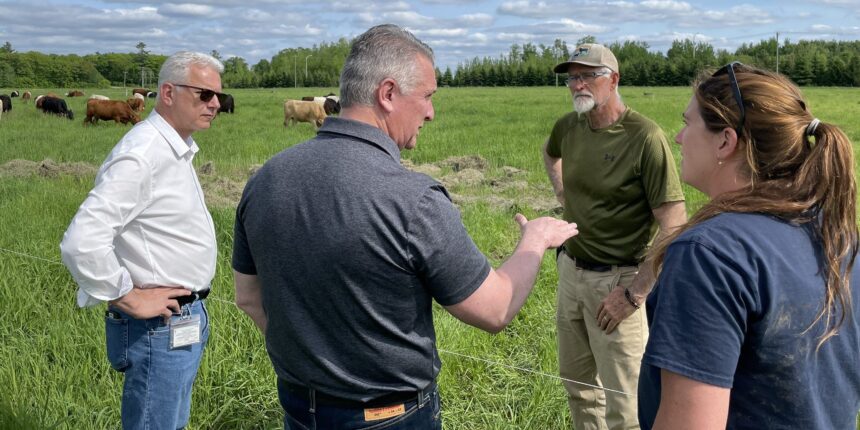The smell of wet earth filled the community centre in Moose Jaw as nearly 200 farmers shook off their rain gear last Thursday evening. They hadn’t come for the free coffee – they wanted answers about where federal agriculture policy is heading.
“I’ve got three kids who want to farm, but how can I tell them to stay when Ottawa keeps shifting the goalposts?” asked Dave Willner, a third-generation grain producer from Swift Current who farms 3,200 acres. His question hung in the air as federal representatives tried to address growing frustration among the agricultural community.
This scene has been repeating across rural Canada this spring, revealing a widening disconnect between food producers and federal policy architects. After three years of pandemic disruptions, climate challenges, and supply chain headaches, Canadian farmers are demanding a clearer vision from the federal government.
The Canadian Federation of Agriculture (CFA) estimates that farmers have absorbed over $4.2 billion in increased costs from carbon pricing, regulatory changes, and supply chain disruptions since 2020. Yet many producers feel their concerns aren’t translating into cohesive policy support.
“We’re not against climate-smart agriculture, but we need tools, not just targets,” explained Mary Drummond, who operates a mixed dairy and cash crop operation near Guelph, Ontario. Drummond’s farm has invested nearly $180,000 in efficiency upgrades over the past decade. “The challenge is that policy seems created in Ottawa boardrooms without boots-on-the-ground understanding.”
The recent federal budget allocated $1.3 billion toward agricultural initiatives, including $495 million for the Sustainable Canadian Agricultural Partnership. While the investment received cautious approval from industry associations, the implementation details remain vague enough to worry many producers.
According to Agriculture and Agri-Food Canada statistics, the sector contributes over $139 billion annually to Canada’s GDP and employs approximately 2.3 million Canadians. Despite this economic significance, many producers feel agricultural priorities take a back seat in federal planning.
“The contradiction is painful,” notes Jean-Martin Fortier, a Quebec vegetable producer who has become a reluctant voice for smaller-scale farmers. “We’re told food security is essential, yet the policies make it harder to produce food domestically.”
The tensions aren’t limited to traditional farm operations. Indigenous food sovereignty advocates point to similar frustrations with federal direction. The National Farmers Union has partnered with several First Nations communities to push for policies that recognize traditional food systems alongside conventional agriculture.
“When we talk about Canadian agriculture policy, whose agriculture are we discussing?” asks Leanne Bear, who works with Saskatchewan First Nations on food security initiatives. “The current approach still treats Indigenous food systems as something separate, when they should be central to the conversation.”
Meanwhile, in British Columbia’s Fraser Valley, greenhouse operators face decisions about expansion versus compliance with environmental regulations. Harjit Gill’s family operation produces vegetables year-round in controlled environments, but rising energy costs threaten their future.
“We’re reducing our carbon footprint per pound of food produced every year, but each new policy seems to ignore that progress,” Gill explained during a provincial agriculture roundtable last month. His operation employs 24 people year-round.
The federal Sustainable Agriculture Strategy released in February was meant to provide clarity, but many industry stakeholders describe it as long on aspirations and short on implementation details. The strategy outlines broad goals around emissions reduction, biodiversity, and water management, but many farmers wanted practical pathways.
Agriculture Minister Lawrence MacAulay has defended the government’s approach, pointing to consultation processes that engaged over 150 agricultural organizations. “We’re working toward a future where environmental sustainability and economic prosperity go hand in hand,” MacAulay stated at a recent press conference.
But farmers like Peter Vander Zaag from Manitoba’s Red River Valley remain skeptical. “I’ve attended these consultations for 15 years, and I’m not convinced our input shapes the final policies,” he told me while checking moisture levels in fields that finally dried enough for spring planting.
The tensions reflect broader questions about rural-urban divides in Canadian policy development. Census data shows that while only about 16% of Canadians live in rural areas, these communities produce the majority of the country’s food.
Industry groups are pushing for what they call “whole-of-government” approaches that consider agriculture impacts in climate, trade, transportation, and immigration policies. The Canadian Agri-Food Policy Institute recently released findings showing that agricultural considerations are often afterthoughts in policies created by other departments.
“We’re not asking for special treatment – just recognition that food production touches nearly every aspect of Canadian life,” explained Tyler Brooks, director of a small-scale processors association in Nova Scotia. His members report spending an average of 22 hours monthly on regulatory compliance, time many small operations struggle to find.
Some bright spots exist in the relationship between producers and policymakers. The federal Local Food Infrastructure Fund has supported over 900 community-based food projects since its launch. Provincial agriculture ministries have sometimes bridged the gap between federal direction and on-farm realities.
“When provincial and federal officials work together with producer input, we tend to get workable solutions,” noted Alberta beef producer Carmen Davidson, who participated in recent consultations. “The problem is that happens too rarely.”
As spring planting continues across the country, farmers are watching Ottawa closely for signals about agriculture’s place in Canada’s future. Many, like the rain-soaked producers in that Moose Jaw community hall, are hoping for clarity that extends beyond election cycles.
“We plant with decades in mind,” Willner told me as the meeting wrapped up. “We just need policies that do the same.”






